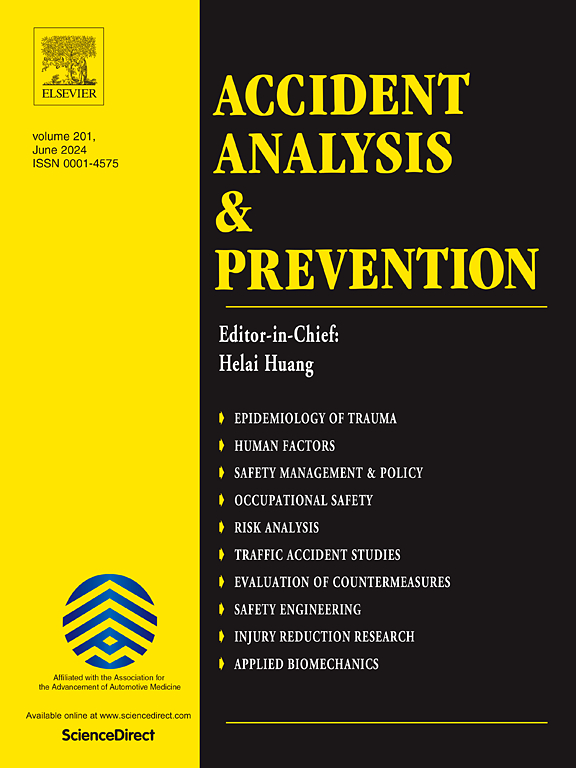Exploring the impact of built environment on crash risks at transportation hubs
IF 6.2
1区 工程技术
Q1 ERGONOMICS
引用次数: 0
Abstract
This study investigates the impact mechanism of the built environment surrounding transportation hubs on crash risks (CR). Three buffer zones (300 m, 500 m, and 800 m) are defined as the spatial analysis units, and Ordinary Least Squares (OLS), Geographically Weighted Regression (GWR), and Multiscale Geographically Weighted Regression (MGWR) are utilized in this study. The results reveals that the 800 m buffer zone provides deeper insights into the factors affecting CR related to the built environment surrounding transportation hubs. Additionally, MGWR demonstrates superior performance in explaining the built environment’s impact on CR compared to the other two methods, with an explanation rate of 83.7 %. To reduce CR near transportation hubs, rationally planning the surrounding land use layout and reducing population density per unit area are recommended. Moreover, the density of road networks surrounding airports and railway stations should be kept at a lower level to reduce CR. The findings of this study contribute to a deeper understanding of the relationship between the built environment surrounding transportation hubs and crashes, providing planning guidance and creating a friendly environment surrounding transportation hubs.
探索建筑环境对交通枢纽碰撞风险的影响
本研究探讨交通枢纽周边建成环境对交通事故风险的影响机制。将300 m、500 m和800 m三个缓冲区定义为空间分析单元,利用普通最小二乘(OLS)、地理加权回归(GWR)和多尺度地理加权回归(MGWR)进行研究。研究结果表明,800 m缓冲带能够更深入地揭示交通枢纽周边建成环境对城市CR的影响因素。此外,与其他两种方法相比,MGWR在解释建筑环境对CR的影响方面表现出优越的性能,解释率为83.7%。为了降低交通枢纽附近的CR,建议合理规划周边土地利用布局,降低单位面积人口密度。此外,机场和火车站周边路网密度应保持在较低水平,以降低交通事故发生率。本研究结果有助于更深入地了解交通枢纽周边建成环境与交通事故之间的关系,为规划指导和营造交通枢纽周边友好环境提供参考。
本文章由计算机程序翻译,如有差异,请以英文原文为准。
求助全文
约1分钟内获得全文
求助全文
来源期刊

Accident; analysis and prevention
Multiple-
CiteScore
11.90
自引率
16.90%
发文量
264
审稿时长
48 days
期刊介绍:
Accident Analysis & Prevention provides wide coverage of the general areas relating to accidental injury and damage, including the pre-injury and immediate post-injury phases. Published papers deal with medical, legal, economic, educational, behavioral, theoretical or empirical aspects of transportation accidents, as well as with accidents at other sites. Selected topics within the scope of the Journal may include: studies of human, environmental and vehicular factors influencing the occurrence, type and severity of accidents and injury; the design, implementation and evaluation of countermeasures; biomechanics of impact and human tolerance limits to injury; modelling and statistical analysis of accident data; policy, planning and decision-making in safety.
 求助内容:
求助内容: 应助结果提醒方式:
应助结果提醒方式:


